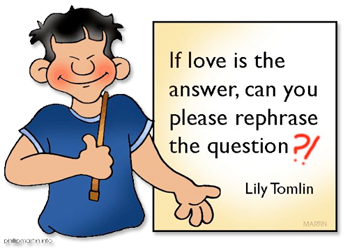Introduction

Source: Repeat the Question?, Phillip Martin
Before you begin the lesson, get into an editing-for-coherence state of mind by reading the following paragraphs.
1. I updated the Status report for the four discrepancies Lennie forward us via e-mail (they in Barry file) . . . to make sure my logic was correct It seems we provide Murray with incorrect information . . . However after verifying controls on JBL – JBL has the indicator as B ???? – I wanted to make sure with the recent changes – I processed today – before Murray make the changes again on the mainframe to “C.”
2. My bedroom is blue, and my computer is in there. I keep most of my textbooks under the bed. It’s a waste of time to make your bed. I told my little sister to never come into my room unless she knocks first. I don’t know about you, but my little sister is a pain. I wish I had some new posters for my walls. These are all old and faded. I guess that if I’d use my desk to study instead of to hold my video games, I’d make better grades.
It’s difficult to get through those two collections of words, isn’t it? The reason for that difficulty is shared by both paragraphs: they lack coherence. The incoherence of the first one is evident; everyone who reads it reacts with the same confused look. A systems analyst in California actually sent that e-mail to her boss at a high-tech company, and her supervisor’s response was to send the analyst to remedial training to improve her writing.
The second paragraph’s words are easier to understand, but the paragraph also lacks coherence. Individual sentences are correct, but together they’re a jumbled mess. They don’t flow together smoothly so that we can see how one idea leads to the next. In other words, we don’t understand the point of the paragraph. Is there a topic sentence in there somewhere?
Such jumpy, disjointed writing—even if it’s about the most interesting topic in the world—is frustrating for readers. Whether writing to a person or for school or work, the point is not only to communicate, but also to communicate clearly. Clarity is sometimes blocked by things like misspellings, unfamiliar jargon or vocabulary, or incorrect punctuation, all of which are evident in the first example paragraph. While you must check these aspects of a final draft, you must also edit for coherence, which is not as readily evident. Simply put, when a paragraph is coherent, the sentences are so clearly connected that readers can easily see how the sentences relate to each other. On a larger scale, when an entire essay is coherent, the paragraphs are smoothly connected.
To underscore the importance of coherence, look at this picture and imagine that the brick building represents an entire essay.
Roof = main idea of the paper
Walls = paragraphs supporting the main idea
Bricks = sentences that make up the paragraphs
Mortar = coherence that holds the sentences and paragraphs together, thus supporting the main idea

Source: Dr Pepper Museum, Ichabod, Wikimedia Commons. Damage inflicted by the 1953 Waco tornado outbreak can be clearly seen in the newer, lighter bricks along the top-front quarter of the building.
Without mortar, which connects bricks into strong walls that support roofs, the building would tumble down. Similarly, without coherence, which binds sentences into clear paragraphs that support the main idea, an essay would also fall apart.
Before we move on, three pieces of background information will be helpful to know.
- Although sentences are the building blocks of paragraphs, paragraphs are the fundamental units of essays. Each paragraph must have unity—strictly adhering to the idea mentioned in the topic sentence—and coherence.
- You will learn how to edit sentences so they move seamlessly from one to another within a paragraph; however, you can use the same methods to ensure that paragraphs move seamlessly from one to another in an entire essay.
- It is much easier to catch coherence problems in other people’s writing than it is to find these problems in your own papers. That’s because by the time you have written and rewritten and finally completed your final draft, your essay makes sense in your own mind. You know what you want the essay to convey, but the question is whether it will make sense to someone else.
By editing for coherence, you can reduce the chances that your writing will confuse readers, whether they are teachers, bosses, or friends.